The Surprising Link Between The Pilates Physical Fitness Method and Manx Cats
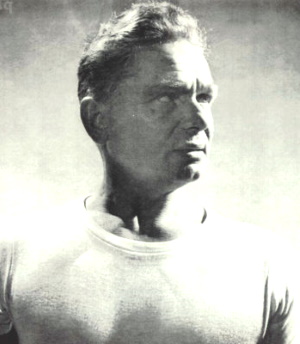
Pilates is a physical fitness method developed in the early 20th century. According to supporters of this exercise system regular pilates can improve posture, muscle tone, balance and joint mobility and at the same time relieve stress and tension. It was created and promoted by German-born Joseph Pilates (December 9, 1883 - October 9, 1967). Less well known is how Joseph Pilates observation of cats when interned as an “enemy alien” during the First World War influenced his development of the exercise. It happened in the Isle of Man (Manx: Mannin), the Celtic island located in the heart of the Irish Sea.
In the Isle of Man, close to the small village of Kirk Patrick (Manx: Skyll Pherick), was once located Knockaloe Internment Camp, which was constructed at the time of the First World War. This catastrophic global conflict originated in Europe and lasted from 28 July 1914 to 11 November 1918. It is estimated that this war resulted in the death of over nine million combatants and seven million civilians. Amongst the victims of this conflict were also those civilians that were viewed at the time as being of enemy nationality. So called “enemy aliens” had their movements restricted during this period which also saw the development of internment camps.
The warring European states interned more than 400,000 "enemy aliens", between the years of 1914 and 1920. The internment of over 32,000 German and Austro-Hungarian civilians by the British state between 1914 and 1919 took place against a background of a rising tide of xenophobia and panic over "imagined" spies in the run-up and after the outbreak of war. The same process was also undertaken in Ireland, which at the time was under British rule. In late 1914, hundreds of German men who were resident in Ireland were arrested as “enemy aliens”, separated from their families and confined for the war’s duration in an old workhouse at Oldcastle, Co Meath. Oldcastle’s prisoners were deported from Ireland in June 1918, when it was deemed the political situation in Ireland was not stable enough for them to be secured there. They were sent to be incarcerated in the existing camp in the Isle of Man.
Knockaloe Mooar farm near the Manx village of Kirk Patrick was identified as the site for the internment camp. Originally designed for 5000 people, by the end of the War it held almost 24,000 internees. The internees were kept in 23 compounds each with four camps made up of wooden hut type buildings inside barbed wire, with the site covering some 22 acres. The first of the civilian male internees arrived on 17 November 1914. The internees subsequently were of various nationalities including German, Austrian, Italian and Turkish. The camps closed in 1919, with a number of those held having served up to five years in the camp. Nearly 200 people died over the years of internment and were buried at Patrick Church which is close to the camp.
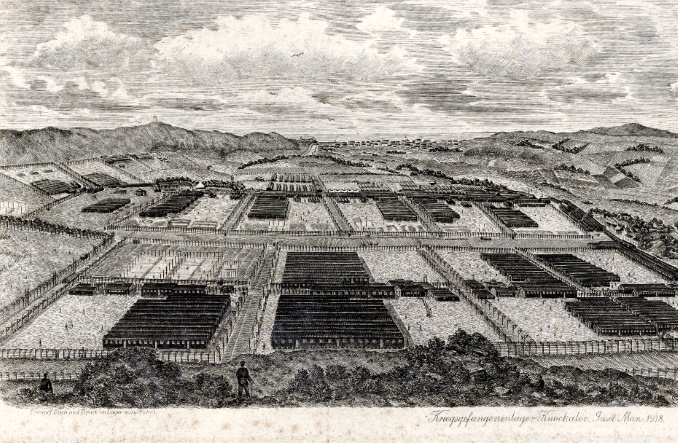
One of the internees was Joseph Pilates. Joseph Hubertus Pilates was born to a poor family in Mönchengladbach, Germany, near the Dutch and Belgian borders, in 1883. He moved to Britain in 1914 and an account of his family background and the circumstances leading to his departure from Germany our given in the website of the excellent Knockaloe Internment Camp & Patrick Visitor Centre. He was a circus performer in England when the First World War began on 28 July 1914. By 5th August he was considered an “enemy alien” and had to register at his local police station. Days later, 30 year old Joseph Pilates was amongst the very early arrests. On 12 September 1915, Joseph Pilates arrived on the Isle of Man. He was to remain there until March 1919 when he left Knockaloe for repatriation to Germany. He later moved to the United States of America where he further developed his technique, patented equipment and opened premises.
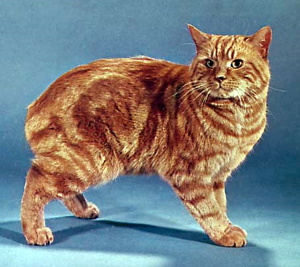
Over the period of internment great hardship was experienced in the camp. Some of which were described by Joseph Pilates himself during an interview by Robert Wernick in an article entitled “Learning to be an Animal” published on 12 February 1962, in Sports Illustrated. He describes his fellow internees sinking into apathy and despair: "as weeks lengthened into months and years." He observed how the daily monotony and the inadequate meals were having a negative impact on the physical and mental health of those held captive. It was at a time when a German submarine blockade was being used in order to try and starve Britain into submission. Over this period, Joseph Pilates observed that the cats in the camp, who were also undernourished, appeared to be coping better than the humans. Some of these cats were no doubt the Manx cat (Manx: Kayt Manninagh), the tailless breed of cat that is native to the Isle of Man, hence the name. He wondered:
Why were the cats in such good shape, so bright-eyed, while the humans were growing every day paler, weaker, apathetic creatures ready to give up if they caught a cold or fell down and sprained an ankle? The answer came to Joe when he began carefully observing the cats and analyzing their motions for hours at a time. He saw them, when they had nothing else to do, stretching their legs out, stretching, stretching, keeping their muscles limber, alive.
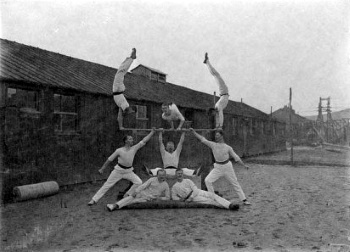
He began working out an orderly series of exercises to stretch the human muscles. His observation of the cats were the inspiration. However, he turned the dire circumstances of his own internment to provide the opportunity to read books on medicine, anatomy and sport. Along with his own gymnastic prowess, he used the time to think and further study the movements and anatomy of humans and animals. His negative experience of internment was turned into a positive and was critical in the development of his methodology. Devising the Pilates physical fitness method that is today estimated to be practised by over 12 million people worldwide. Those who have benefited from using the method are no doubt grateful to Joseph Pilates, but perhaps they should also spare a thought for the cats in the small Celtic island of the Isle of Man who also made their contribution. There is, after all, always a lot that humans can learn from other animals.
Knockaloe Camp was closed and dismantled after the war. The site of its location quickly reverted back to farmland. It would appear that not many records of individual internees survived from the First World War. One of the few people who tried to preserve the experiences of German internees was the Manx writer Hall Caine (1853-1931), who published The Woman of Knockaloe in 1923. It tells the story of a young Manx woman who has a romance with a German prisoner of war. They face the fierce hostility of the local community which eventually drives them to commit suicide. The book was the basis for the 1927 American silent romance film Barbed Wire starring Pola Negri and Clive Brook. Following the film’s release the novel was re-published under the title, Barbed Wire.
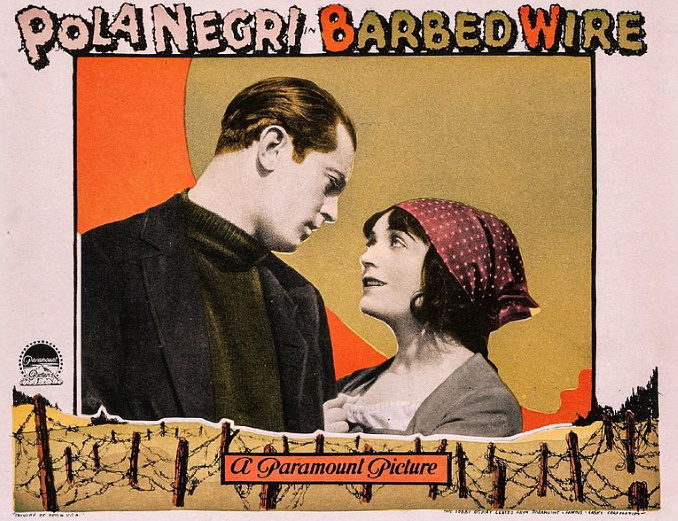
Knockaloe Internment Camp was a British operation and not one inspired by the Isle of Man authorities. However, over the years many Manx people have taken an increased interest in the lives and experiences of those who were interned on their Island in those dark days. Those undertaking research are building an archive on the people who were kept there. This is also a source of information for the many enquiries received from people whose family members were interned at Knockaloe. The village of Patrick started a project some years ago to create Knockaloe Internment Camp & Patrick Visitor Centre in the old village of Patrick, information on which can be found on their website www.knockaloe.im . The centre is well worth a visit. It recognises the important part the camp played in Manx history and seeks to gain increased knowledge of the lives and experiences of those unfortunate internees imprisoned there.
- Manx
- English






